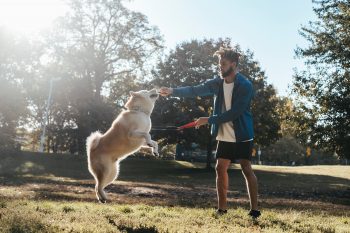The Akita is a powerful and dignified breed from Japan, known for its loyalty and strong presence. As a breed that was originally used for hunting large game, Akitas possess a significant amount of energy and require adequate exercise to maintain their health and happiness. This article will examine the types and amounts of exercise that best suit the Akita.
1. Determining Exercise Requirements for Akitas
Akitas need a considerable amount of exercise, usually around 1 to 2 hours daily. They thrive on a routine that includes both physical and mental stimulation due to their working breed nature.
2. Understanding the Impact of Exercise on Akitas
Regular exercise is vital for Akitas to prevent obesity, keep their joints healthy, and minimize potential behavioral problems. A well-exercised Akita is typically more even-tempered and sociable.
3. Appropriate Exercise Types for Akitas
Suitable exercises for Akitas include brisk walks, jogging, and play sessions in a secure, enclosed area. They also enjoy activities that challenge them mentally, such as obedience training and puzzle games.
4. The Role of Mental Stimulation in Exercise
Mental stimulation is crucial for the intelligent Akita. Incorporate training sessions into their exercise routine to keep their minds active and prevent boredom.
5. Socialization and Exercise
While Akitas can be aloof, socialization is important for their development. Structured activities that allow them to interact with other dogs and people in a controlled environment can be beneficial.
6. Customizing Exercise for Your Akita’s Age
Exercise regimens should be adapted to the age of your Akita. Puppies have different energy levels and require shorter, more frequent periods of play, while seniors need gentle, less strenuous activities.
7. Seasonal Exercise Considerations
Akitas have a thick double coat that can make them prone to overheating in hot weather. Exercise routines should be adjusted according to the season to ensure their comfort and safety.
8. Recognizing the Signs of Adequate Exercise
A well-exercised Akita will have a balanced temperament, maintain a healthy weight, and sleep soundly. Signs of inadequate exercise can include anxious behavior, weight gain, or destructive tendencies.
9. The Importance of Consistency
Consistent exercise schedules help Akitas to manage their energy levels and reduce stress. A predictable routine can be very reassuring to this breed.
10. Regular Health Evaluations and Exercise Adjustments
Regular check-ups with a veterinarian can ensure that the exercise routine of your Akita remains appropriate as they age and as their health needs evolve.
Conclusion
Exercise is a fundamental aspect of an Akita’s daily routine, contributing significantly to their physical and mental well-being. A balanced approach that includes a variety of physical activities and mental challenges will ensure your Akita remains a healthy and integral member of your family. Consult with a veterinarian to create an exercise plan that is tailored to your Akita’s specific needs.
Frequently Asked Questions About Exercising An Akita
1. How much exercise does an Akita require daily?
An Akita requires around 1 to 2 hours of exercise each day. Due to their high energy levels and strength, this breed benefits from structured physical activity that includes both vigorous exercise and opportunities for mental stimulation.
2. What type of exercise is most suitable for an Akita?
The most suitable exercises for an Akita include long walks, jogs, and play sessions in a securely fenced area. They also enjoy mentally challenging activities such as advanced obedience training, agility courses, and interactive play that requires problem-solving.
3. Can Akitas go on hikes with their owners?
Akitas can be great companions for hiking due to their endurance and protective nature. They should be kept on a leash to manage their strong prey drive, and it’s important to provide them with enough water and rest during the hike.
4. Are Akitas suitable for dog parks?
Akitas may enjoy dog parks, but their interaction with other dogs should be monitored closely. They have a dominant personality that can lead to aggression if not socialized properly, so it’s important they are well-trained and can be recalled easily.
5. How do I know if my Akita is getting enough exercise?
If your Akita is relaxed and well-behaved at home, maintains a healthy weight, and sleeps soundly, they are likely getting enough exercise. Akitas that do not receive enough physical activity may exhibit signs of restlessness, destructive behavior, or aggression.
6. What are signs of over-exercising an Akita?
Signs of over-exercising an Akita include excessive panting, lethargy, and reluctance to move or continue exercising. They may also show signs of soreness or discomfort after activity.
7. How can I provide mental stimulation for my Akita during exercise?
To provide mental stimulation during exercise, integrate training exercises into physical activities, use puzzle toys that encourage problem-solving, and set up obstacle courses that challenge their mind and body.
8. What precautions should I take when exercising my Akita in hot weather?
In hot weather, exercise your Akita early in the morning or late in the evening when temperatures are cooler. Ensure they have access to plenty of water and avoid intense physical activity during the heat of the day.
9. Do Akitas enjoy water and swimming?
Some Akitas may enjoy swimming, which can be an excellent form of low-impact exercise, particularly for older dogs or those with joint issues. Always supervise them around water as they can be heavy and not all are natural swimmers.
10. How should exercise routines be adjusted for a senior Akita?
Senior Akitas may require less intense exercise. Gentle walks and short play sessions tailored to their comfort level are important, along with regular mental stimulation to keep them engaged and happy.
The post How Much Exercise Does a Akita Need? appeared first on iHeartDogs.com.

